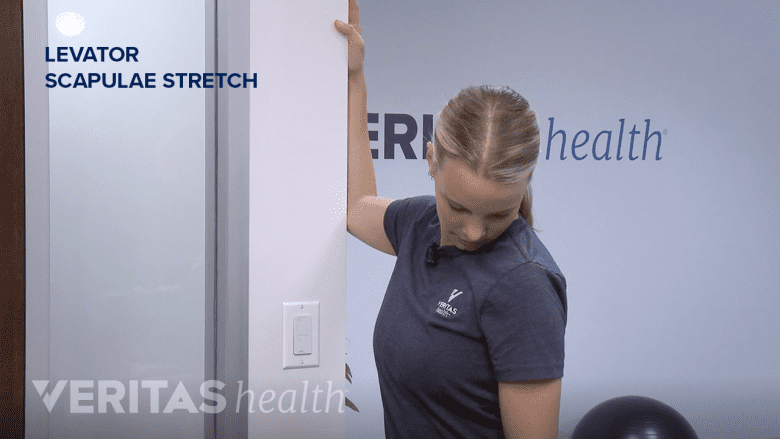When the neck becomes stiff or sore due to a muscle strain, the long levator scapulae muscle that runs down the side of the neck and into the shoulder is commonly one of the muscles involved. Paying special attention to keep both levator scapulae muscles stretched and flexible may make them more resistant to becoming stiff and painful.

The levator scapulae stretch reduces neck and shoulder blade pain.
In This Article:
- Daily Exercises and Stretches to Prevent Neck Pain
- Easy Chin Tucks for Neck Pain
- Easy Levator Scapulae Stretch for Neck Pain
- Easy Chest Stretches for Neck Pain
- 3 Gentle Stretches to Prevent Neck Pain Video
Step-by-Step Guide for the Levator Scapulae Stretch
Here is a version of the levator scapulae stretch that can be performed while seated:
- Sit up straight with both hands at the sides.
- Raise the right arm forwards and reach over the back with the hand grasping the right shoulder blade and applying downward pressure. (This step rotates the shoulder blade downward, which helps lengthen the levator scapulae muscle even more before it is stretched. If raising the elbow above the shoulder is too complicated at first, this step can be skipped.)
- While keeping everything else still, rotate the head to the left about 45 degrees (which is about halfway toward the shoulder).
- Tilt the chin downward until a good stretch is felt on the back right side of the neck.
- To increase the stretch further, the left hand can be brought up to the back of the head to gently pull down a little more.
- Hold for 30 to 60 seconds, or as tolerated.
- Repeat on other side.
Most recommendations are to perform this stretch a few times per day, such as in the morning and in the afternoon. Some people may benefit from performing the stretch even more often or when neck tightness first starts to develop.
Variations of the Levator Scapulae Stretch

The levator scapulae stretch helps reduce neck and shoulder blade pain.
There are many variations on the levator scapulae stretch. For example, the hand and elbow can be raised and placed on a nearby wall or door jamb, rather than grabbing the back of the shoulder. As long as the elbow is held above the shoulder and the shoulder is not allowed shrug upwards, these various positions all have a similar effect of lengthening the levator scapulae muscle before doing the rest of the stretch.
Preferences for how to perform the levator scapulae stretch may depend on the setting or what is available. In an office environment, it might be easier to perform the levator scapulae stretch while seated, whereas at home it might be preferable to do the stretch while standing.
How the Levator Scapulae Stretch May Reduce Neck Pain
The levator scapulae muscle aids in shoulder elevation and neck rotation.
The levator scapulae muscle connects to the transverse processes of the top four cervical vertebrae (C1 to C4) and runs down the side of the neck where it eventually connects with the scapula (shoulder blade). Each side of the neck has a levator scapulae muscle, which plays an important role in several movements, such as raising the shoulders and rotating the neck.
Due to its length and attachments to different mobile areas of the body, the levator scapulae muscles are particularly susceptible to becoming strained and painful. Gently stretching the levator scapulae muscle may bring some relief to a tight or sore muscle, and keeping this muscle stretched and flexible may reduce the risk of neck pain returning.

